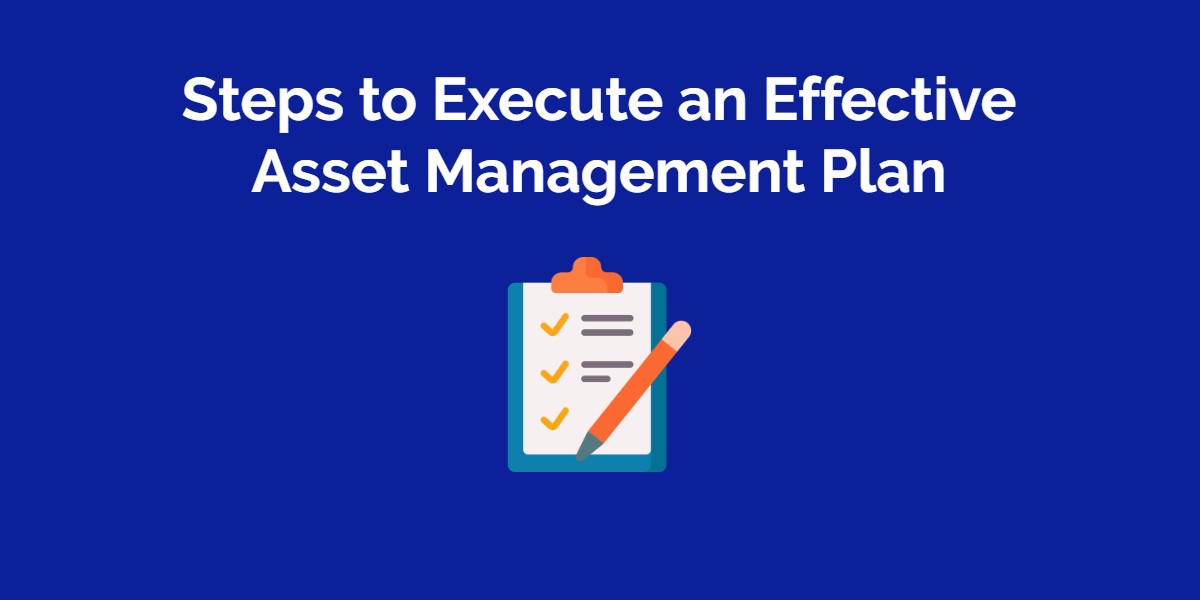Creating a sound asset management plan is the cornerstone of effective asset management process implementation. Sound asset management practices offer your organization many benefits, including increasing the lifecycle of each asset while enabling your team to gain maximum utility, and improving overall productivity. A systematic approach toward tracking a wide variety of assets also ensures that your assets are well-maintained at all times and ready for use.
Asset management planning covers the broader asset infrastructure of your organization, and provides an integrated approach to both operating and maintaining assets. This streamlines management efforts, maintains a high standard of service and helps ensure that key operational objectives are achieved. A successful asset management plan yields several advantages for your business, including:
- Achieving goals faster: Effective resource management and categorization is essential for simplifying work processes and implementing faster administrative workflows. These goals are heavily dependent on accurate records management, which are possible only when an effective asset management plan is in place. A plan makes it possible for your team to cross-check your company’s management objectives with current performance so that a baseline for benchmarking can be established. By outlining clear implementation steps in your plan, you will prepare your team to achieve asset management objectives faster and more effectively.
- Reduced asset downtime: An important component of an asset management plan is establishing procedures for the maintenance and repair of assets, and the implemention of maintenance schedules. Consistent service delivery is critical for the support of efficient operations by ensuring that downtime is minimized. According to recent studies, equipment downtimes cost an estimated $50 billion annually. To make sure your organization does not have to suffer the consequences from downtimes, your plan can incorporate preventative maintenance, with regular audits to analyze assets’ condition, and ensure that unplanned downtimes are minimized.
- Improved compliance: Following a management plan makes it easier for your team to comply with safety standards. As a good plan highlights how an asset is to be treated, what is the long term aim of the asset and the objectives it is meant to fulfill. An asset’s maximum capacity can be achieved by keeping all of these aspects in mind, and by following a compliance checklist. Asset management that is aligned with rules and regulations that increase the safety of assets (and their users) help you to achieve the end-purpose of the asset as well as staying audit-ready.
Read more: 4 Important Asset Management Goals to set for your business

How can you implement an asset management plan?
Successful implementation of an asset management plan is straightforward, and requires following a few steps, including the following:
Step 1: Set strategic objectives
In order to create a plan which aligns with your company’s goals, it is important to set specific, measurable, achievable, relevant and time-bound – “SMART” – goals. These goals must align with your company’s vision as they help sustainability in the long run. Strategic objectives are formulated to help lead your activities towards your company’s overall aims, such as higher efficiency, increased productivity and improved ROI. The objectives can include a variety of short term and long term goals, but need to be realistic with a specific timeline defined. Asset management goals are the key to making sure that you can maximize asset optimization. For example, for a construction company, goals might look like this:
- Prolong asset lifecycle: Heavy construction equipment is costly and requires timely maintenance. Such assets can be scheduled for early maintenance sessions as per the asset maintenance plan in order to ensure that they are never out of date or underperforming.To extend their lifespan, an organization would focus on preventive maintenance since repair after a failure can be more costly, slower, and increases unplanned downtime.
- Keep service history records: Keeping a detailed record of your construction equipment’s service provides useful data that helps account for how the assets are being utilized. To fulfill this aim, your team can employ tools that maintain asset logs and asset history. These tactics make it easier for you to decide when an asset is no longer fit for operations or has failed to fulfill its intended lifespan.
Establishing clear objectives helps you expedite the formulation and implementation of an asset management strategy.
Step 2: Create an asset repository
Having a complete record of what assets you own is vital to managing them. If you do not know what asset you possess, then you will not be able to generate a plan that applies to all of your assets. By creating a repository, you can always know what assets are being utilized by your business, what categories the items belong to, what their life cycles are and their value. A cloud based solution is useful in storing this information because you can cross-reference asset details with the platform data. In this way, asset levels can be analyzed quickly, and assets can also be readily made available when needed.
This also helps keep the asset lifecycle in check. So, if an asset is near the age of retirement, alternatives can be arranged to continue operations without disruption. Through asset categorization, more useful and frequently used assets can be prioritized for maintenance and repair as well- accelerating organizational efficiency.
Step 3: Generate asset criticality assessment
For you to be able to provide continuous service, it is important to analyze the functions fulfilled by your assets. Depending on the functions your assets perform, you can determine maintenance, replacement and operational protocols. The nature of work also determines the use of an asset, which in turn directly impacts an asset’s overall functionality, such as the number of hours it is used. Let’s suppose you run an event management business, and as a part of the package you provide photography services. In this case, you will require camera batteries with sufficient life to last a full event. The condition of the cameras, batteries and associated lenses need to be checked so that they do not malfunction while capturing the event. By following your asset management plan, you would carry out timely repairs and inspections that ensure top performance.
Also, Levels of Service (LOS) need to be maintained to ensure that asset performance meets the target performance goals and your organization’s strategic aims. LOS helps identify what service each asset is providing, and ensures reliable and quality asset performance. To measure and maintain acceptable LOS, an asset management plan should include a continuous performance assessment plan. This includes measurements of performance, where assets are analyzed periodically and they meet the required criteria of safety and operations.
Step 4: Analyze and implement asset maintenance systems
One of the foremost aims of asset management includes carrying out cost analysis. Assets need repairs from time to time which is crucial to sustaining business operations, and it is best to adopt a maintenance system that is as cost-effective as possible. Two types of maintenance activities are common: reactive and proactive. For example, if you manage a school, then repairing a broken down PC in a computer lab – reactive maintenance – will cost more than carrying out regular checks – proactive maintenance – to check hardware performance and provide upkeep, as needed. A proactive maintenance strategy is ultimately more cost-effective over time because it prevents an asset from complete breakdowns, which are almost always more costly.
Step 5: Financial Planning
One of the long term aims of an organization is to achieve financial security. A successful asset management plan manifests into objectives that includes executing your business’s financial plans. Such a plan highlights your asset portfolio, and requires documentation with data that includes:
- Asset’s net value
- Annual depreciation expense
- Maintenance and repair costs
- Asset’s operational cost
- Replacement cost
This information helps your team manage assets in a cost-effective manner, while operating within the budget available to fulfill each department’s asset needs. Also, financial planning facilitates preparing for a large expenditure, such as acquiring a new asset, or even improvements to an existing asset in order to maintain it according to your organization’s defined standards. Therefore, a comprehensive asset management plan is important to ensure that your business is aware of its asset landscape, and helps facilitate solid financial planning and management practices.

Why should you have an asset management plan?
A well-documented asset management plan is useful to minimize costs and improve operations. Effective planning also helps develop accuracy in asset records, and saves you from asset loss or misuse. Precise tracking is another major benefit of strategic asset management planning because the system is designed to keep your team informed about where your assets are being utilized, their performance and condition. Having control over your assets is a significant step toward ensuring that your assets are serving your objectives, and also helping ensure that your organization’s established standards of service are well-maintained.
About EZOfficeInventory
EZOfficeInventory is a leading asset tracking software. It allows you to track, maintain, and report on inventory from anywhere, at any time. We offer a free 15-day trial – no credit card required!







